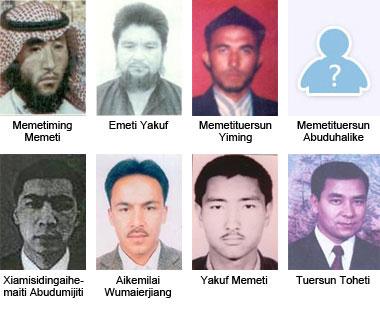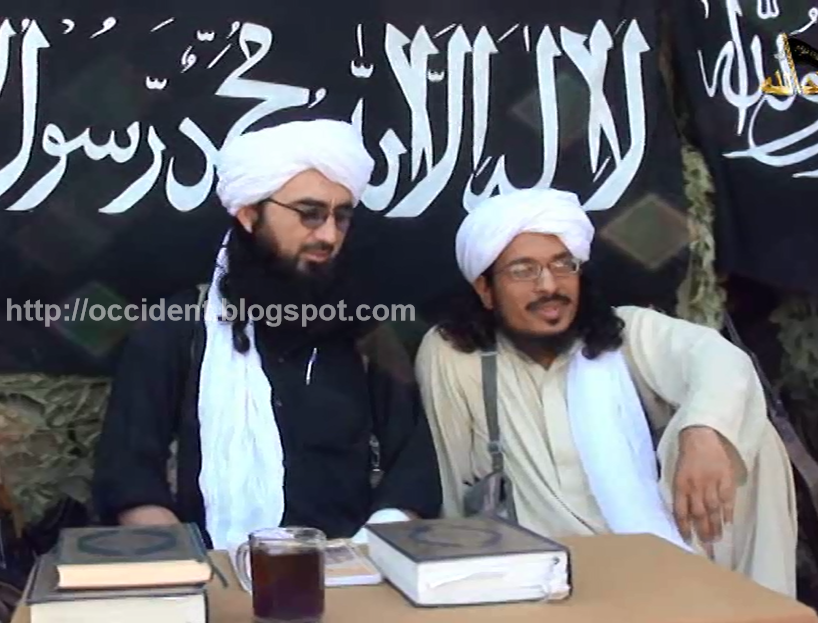Media personnel take footage of seized weapons at an empty bazaar during a military operation against Taliban militants in the main town of Miramshah in North Waziristan on July 9, 2014. — Photo by AFP
Zarb-i-Azb: The 'War of Survival'
A 'war of survival'?
Is Operation Zarb-i-Azb really the war for Pakistan's survival, as has been claimed by the army?
What was the final push that led to the operation?
How is Zarb-i-Azb different from past operations?
For years, North Waziristan has remained an operational nerve center for militants — both foreign and local — linked to Al-Qaeda and pursuing the agenda of global jihad
Compilation of Uzbek/Uighur terrorist mugshots issued by the Chinese government, some of whom were killed in North Waziristan drone strikes. — Photo by AFP
Usman Ghazi and Abu Zarr Al-Burmi, commander and mufti of Waziristan-based Islamic Movement of Uzbekistan (IMU). — Photo courtesy Views from the Occident 

Smoke rises after militants launched an early morning assault at Jinnah International Airport in Karachi on June 9, 2014. Pakistan's security forces said on June 9 they have relaunched a military operation at Karachi airport as gunfire resumed several hours after they announced the end of a militant siege that left 24 dead. — Photo by AFP For example, the Bannu jailbreak in April 2012 and the recent attacks on Karachi and Peshawar airports were linked to the restive agency.
Operation Zarb-i-Azb: why now?
Top left: PNS Mehran Air Base attack; top right: damaged plane at PNS Mehran Air Base attack; bottom left: tattoos from Daghestani militant killed in gun battle at PAF airbase in Bacha Khan Airport (2012); middle right: morning after attack at Kamra Air Base; bottom right: aircraft visible from Airport Road the morning after Peshawar airport attack (2014)
External pressure
U.S. Army Gen. David H. Petraeus, second from right, the new commander of the NATO International Security Assistance Force in Afghanistan, visits with U.S., NATO and Afghan forces at checkpoint 91 in Kandahar, Afghanistan, July 9, 2010 — Photo by ISAF
An operation in North Waziristan to target the Haqqani network has been a running demand from the US and its allies fighting in Afghanistan
A black Jihad flag, handcuffs and chains are displayed in a house used by Taliban militants as a prison after a military operation against the militants in the town of Miramshah in North Waziristan July 9, 2014. — Photo by Reuters
So what ended the complacency of nearly four years in North Waziristan? Multiple factors may be elicited as possible explanations.
Moving militants
Image shows Azerbaijani passport recovered from an Al-Qaeda linked militant killed in Kurram Agency in 2012. — Photo by Dawn News.
The free movement of TTP and Al-Qaeda-linked militants into surrounding areas of Pakistan became a serious challenge.
Mullah Fazlullah — File photo
Foreign fighters
Militant fighters targeted in preceding operations, such as Swat, were controlled by local leaders led by Mullah Fazlullah. In contrast...
Image from IMU statement claiming the Karachi airport attack shows the ten men responsible.
... militants fighting Pakistan security forces in North Waziristan, apart from including foreigners, are also foreign-led.
Cleaning house
The Pakistani state had to tackle militancy, even though it was initially unwilling to take on the Haqqani network and the 'Good Taliban' such as Hafiz Gul Bahadur.
Media personnel take footage of seized weapons at an empty bazaar during a military operation against Taliban militants in the main town of Miramshah in North Waziristan on July 9, 2014.— Photo by AFP
Key difference
A soldier stands in an armoured vehicle during a military operation against Taliban militants in the town of Miramshah in North Waziristan July 9, 2014. — Photo by Reuters
In this operation, Pakistani security forces face foreign and Al-Qaeda linked
militants which include...
Image shows IMU fighters in NWA. Ali Al-Abzi from Russia (centre) carried out a suicide attack against Balochistan IG Police Mushtaq Sukhera in May 2013
... Uzbeks, Turkmen, Chechens, and even Europeans. These foreigners have enjoyed safe haven for decades since they arrived to fight against the Soviet invasion of Afghanistan.
Global jihadis, global outlook
A map purportedly showing the areas ISIS plans to have under its control within five years — Online
Mobile and international fighters mean the jihadis have an international outlook. Groups led by foreign militants — in association with local subsidiaries — want a global "caliphate" using Pakistan as a springboard, whereas local extremists — driven by local leaders — want their share of power, autonomy, and governance.
Image from an IMU video claiming the attack shows a hand drawn map of Bannu jail. Waiting it out
The military also opted to take advantage of TTP's damaged structure thanks to the infighting which has left scores dead — fighters and civilians alike.
Pakistani Army patrols a street in Miramshah bazaar on July 9, 2014. — Photo by Dawn News
Ultimately, the Karachi airport attack was the "triggering point", according to Peshawar University professor Hussain Shaheed Sohrwardi.
Soldiers walk past seized weapons at an empty bazaar during a military operation against Taliban militants in the main town of Miramshah in North Waziristan on July 9, 2014.— Photo by AFP Miramshah bazaar on July 9, 2014 — Photo by Dawn News
However, it remains to be
seen whether the North Waziristan operation is a solution that might be effective in the
long term as well as the short term.
Watch this space for the second installment of this report.
Text by: Zahir Shah Sherazi
Produced by: Mahnoor Bari
Photos by: AFP, Reuters, Dawn News, Zahir Shah Sherazi, ISAF, online sources